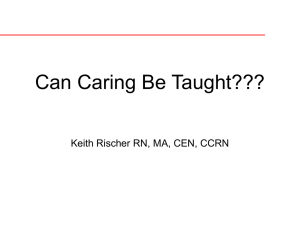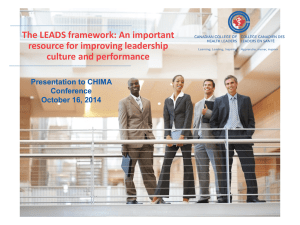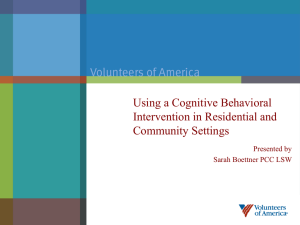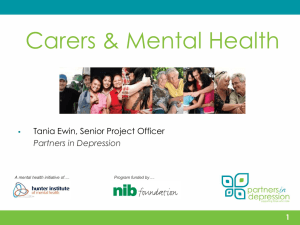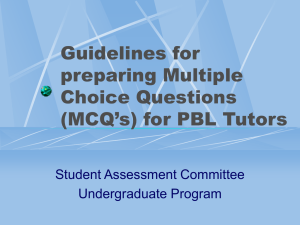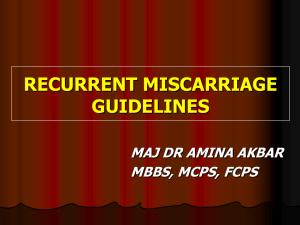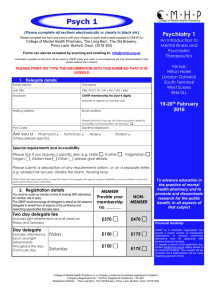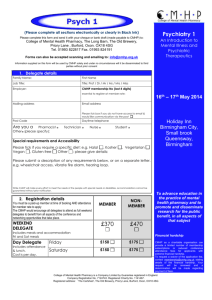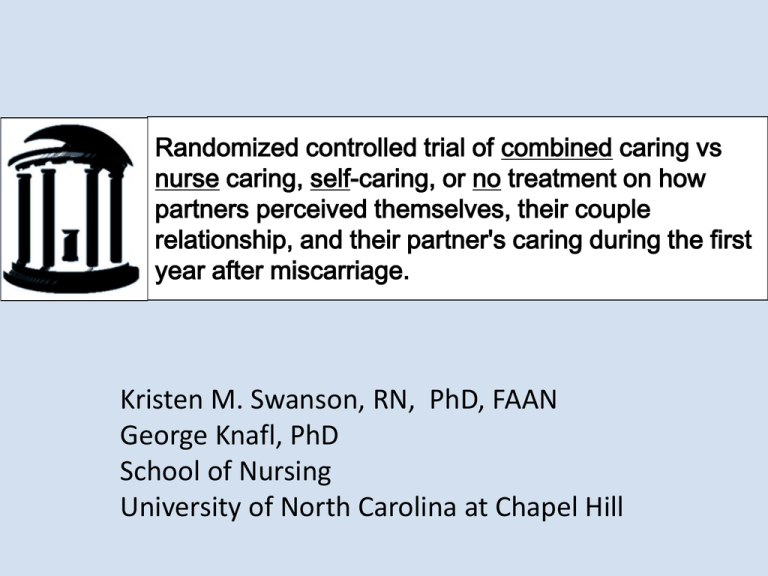
Randomized controlled trial of combined caring vs
nurse caring, self-caring, or no treatment on how
partners perceived themselves, their couple
relationship, and their partner's caring during the first
year after miscarriage.
Kristen M. Swanson, RN, PhD, FAAN
George Knafl, PhD
School of Nursing
University of North Carolina at Chapel Hill
BACKGROUND
• At least 1 in 6 pregnancies end in miscarriage: the
unplanned, unexpected loss of pregnancy prior to 20
weeks gestation (Ventura et al, 1999).
• Both men and women grieve after loss, with depth and
duration of women’s grief tending to be greater (Swanson et
al, 2009).
• When asked what was lost, typically mothers say their
baby; spouses say their partner (Wojnar et al, 2011).
• One year after loss approx. One-third of women claim
their couple and / or sexual relationships are more
distant than before their miscarriage (Swanson et al, 2003).
RESEARCH QUESTION
Are there differences in how partners perceive
themselves, their couple relationship, and their
partner's caring during the first year after
miscarriage based on whether couples received
Nurse Caring, Self Caring, Combined Caring, or
no treatment?
Couples Miscarriage Healing Project
CMHP TEAM
Kristen M. Swanson, RN, PhD, FAAN
George Knafl, PhD
Carolyn Huffman RN, MSN, AWHNP
Anthippy Petras, MSW
Danuta Wojnar, RN, PhD
Hsien-Tzu Chen, RN, PhD
Rosalie Houston, RN, MN
Susan Sandblom, ARNP, MN
Jeannette Quaeck, RN, MN
Appalachia Martine, RN, BSN
Helga Fridjonsdottir, RN, PhD
Alyson Shapiro, PhD
Christopher Graham, PhD
1 R01 NR 05343-01A1
RECRUITMENT
RECRUITED
• Posters, ads (newspaper, radio), provider referral
SELECTION CRITERIA
• Miscarried w/in last 3 mos.
• In a committed relationship
• Speak / write English
• If not married, both must be 18
• Both parents consent and return baseline data
ENROLLMENT
(January, 2003 to June, 2006)
Screened
Eligible
Enrolled
Retained
• 418 volunteers
• 393 couples
• 341 couples
• 324 couples
DEMOGRAPHICS
Women
Men
Age
32.4
33.9 *
College Education
91%
87%
Caucasian
84%
86%
Employed
69%
87% *
Mental Health Tx
49%
26% *
COUPLES
• Together
• Children
(M = 6.9 yrs; SD = 4.5)
• Miscarriages
(range = 1 to 6)
(range = 0 to 6)
(0 = 53%; 1 = 31%)
(1 = 68%)
• Pregnancy planned 72%
• Pregnancy wanted 98%
• Ges. age at loss
(M = 9.8 wks; SD = 3.1)
INTERVENTION
• PROCESS (Swanson Caring Theory)
• CONTENT (Meaning of Miscarriage Model)
• Four Arms
– Nurse Caring (3 counseling sessions)
– Self Caring (3 videotape & workbook modules)
– Combined Caring (1 counseling & SC modules)
– Control (no treatment)
DESIGN
1
Phone
screen
5
11 weeks
X
nurse
X
X
selfX
X
X
combined
X X
X
randomized
control
Baseline
t2
t3
t4
1 mo.
3 mos.
5 mos.
13 mos.
Time since miscarriage
MEASURES
Concept
INTIMACY
SELF
PARTNER
CARING
Total
PAIR
Emotional
(Shaefer & Olson, Social
1981)
Sexual
Intellectual
Chronbach alpha
Men
Women
.888 - .917
.901 - .931
.811 - .860
.863 - .902
.707 - .760
.729 - .799
.795 - .843
.749 - .803
.756 - .804
.797 - .843
Total
How I See Myself
Emotionally Strong
(Swanson)
Satisfied
.876 - .902
.850 -.886
.784 - .831
.885 - .906
.848 - .899
.798 - .875
.848 - .876
.795 - .847
.817 - .869
.895 - .905
.882 - .888
.826 - .881
Measure
How My Mate
Cares
(Swanson)
Scales
Total
Mutual Sharing
Cares for Me
DATA
• 1,739 PAIR Total measurements
• for 636 subjects
• 321 women
• 315 men
• from 324 families
• from 1-6 PAIR Total measurements per
couple
ANALYSIS
• Elapsed days since loss
• Controlled for baseline values
• PAIR Total used to determine the analysis
model that best fit the data
MODEL REFINEMENT
1. Started with most complex model including all
main effects and all interaction effects.
(used to select covariance structure)
2. Guided by Cross Validation (CV) values, reduced
the model systematically to obtain best fit model.
3. Best fit model deployed to analyze all other scales
and subscales.
Selected Covariance Structure
• Covariance structure selection was based on a 2dimensional structure (time and spouse)
• correlation between partners
– at the same time had estimated value 0.30
– decreased as time between measurements increased
• correlation across time within partner
– 10 weeks apart had estimated value 0.46
– decreased as time between measurements increased
• standard deviations increased over time
– but same for partners at each time
STEP 1: FULL MODEL
Main effects
group (4 levels) p = 0.337
gender (2 levels) p = 0.585
elapsed days since loss (continuous) p = 0.396
Conclusion:
Only baseline value is significant.
All two way interactions
group X gender p = 0.673
Question:
some
non-significant
terms be masking
groupMight
X elapsed
days
p = 0.796
effectsgender
of other
terms?days p = 0.449
X elapsed
Three way interaction
group X gender X elapsed days p = 0.973
Baseline value p < 0.001
STEP 2: ADDITIVE MODEL
Eliminated all interaction effects
Conclusion: On
one to oneCV
comparison,
groupmodel
stood
Generated
an aimproved
score, so no
better
out as effects
significantly different.
Main
group
(4 levels)
0.198way to compare
Question:
Might
there bep a=better
groups?
One group
vs. all p
others,
two groups vs. two
gender
(2 levels)
= 0.463
groups, etc.?
elapsed days since loss p = 0.101
Baseline value p<0.001
STEP 3: REFINED GROUP EFFECT MODEL
Sought best CV score for all possible combinations of
the 4 groups into subgroups
Main
effectsThere was a significant positive effect for
Conclusion:
combined
caring vs.
all other
was masked
in
Combined
Caring
(CC)groups
versusthat
all others
p = 0.042
prior models.
mean post-baseline Pair Total increased by an
estimated 1.9 units for CC vs. all other groups
Question:
Does
this
gender
(2using
levels)
p model
= 0.461selected for Total Intimacy
lead toelapsed
similar conclusions
for other
measures?
days since loss
p = 0.103
Baseline value p < 0.001
COMBINED CARING vs ALL OTHER GROUPS
RESULTS
Combined Caring vs All Other Groups
p-values for fixed effects
INTIMACY
SELF
PARTNER
CARING
estimates when significant
variable
N of
families
PAIR Total
emotional
social
sexual
intellectual
324
324
324
324
324
N of postbaseline
measures
1769
1770
1769
1769
1769
elapsed
gender
baseline
combined time since
(male)
value
loss
0.461
0.042
0.103
<0.001
0.182
0.034
0.314
<0.001
0.268
0.965
0.098
<0.001
0.049
0.049
<0.001
<0.001
0.975
0.009
0.828
<0.001
Total
emo. strength
satisfied
324
324
324
1779
1779
1779
0.812
0.877
0.818
0.032
0.145
0.010
<0.001
0.001
<0.001
<0.001
<0.001
<0.001
1.10
Total
cares for me
mutual sharing
323
324
323
1767
1769
1767
0.552
0.926
0.242
0.004
0.100
0.001
0.007
0.880
<0.001
<0.001
<0.001
<0.001
1.59
gender
baseline
combined
(male)
value
1.90
0.70
-0.43
0.65
0.73
0.62
0.97
0.80
0.73
0.72
0.70
0.75
0.67
0.67
0.60
0.63
0.62
0.54
DISCUSSION & CONCLUSIONS
Should Miscarriage be studied as an occasion
for adjustment, recovery, or growth?
Transition: CMHP findings for Grief
WOMEN - (CC = NC = SC) > (control)
MEN - (CC = NC) > (SC and control)
Pathology: CMHP findings for Depression
WOMEN - NC > (CC, SC, control
MEN - (NC = control) > (SC = CC)
Growth: CMHP findings for Relationships
CC > (NC, SC, control)
CONCLUSIONS
1. During the first year after miscarriage,
compared to those receiving NC, SC, or no
treatment, men and women receiving CC
rated their partner as more caring and they
experienced less decline in their relational
intimacy and perception of self.
2. Findings suggest that CC empowered
couples to turn to each other as they
resolved their miscarriage.
References
Shaefer, M. T. & Olson, D. H. (1981). Assessing intimacy: The PAIR Inventory. J of
Marital and Family Therapy, 7, 47-60.
Swanson, K. M. (1991). Empirical Development of a middle range theory of caring.
Nursing Research, 40, 161-166.
Swanson, K. M., Chen, H. T., Graham, J. C., Wojnar, D. M.. & Petras, A. (2009).
Resolution of depression and grief during the first year after miscarriage: A randomized
controlled clinical trial of couples-focused interventions. J Women’s Health and Genderbased Medicine, 18(8), 1245-1257.
Swanson, KM, Karmali, Z, Powell, S. & Pulvermahker, F. (2003). Miscarriage effects on
interpersonal and sexual relationships during the first year after loss: Women's
perceptions. J of Psychosomatic Medicine, 65(5), 902-10.
Ventura, S. J., Mosher, W. D., Curtin, M. A., Abma, J. C., Henshaw, S. (1999). Highlights
of trends in pregnancies and pregnancy rates by outcome: Estimates for the United
States, 1976-96. USDHHS National Vital Statistics Report 47(29).
Wojnar, D., Swanson, K. M., Adolfsson, A. (2011). Confronting the inevitable: A
conceptual model of miscarriage for use in clinical practice and research. Death
Studies, 35(6), 536-558(23).
MODEL SELECTION
• Model selection was independent of p-values
• Based on cross validation (CV) scores
– Data randomly partitioned into subsets
– Subsets predicted using parameter estimates
based on the rest of the data
– Predictions combined into a score
– With larger CV scores indicating better models



